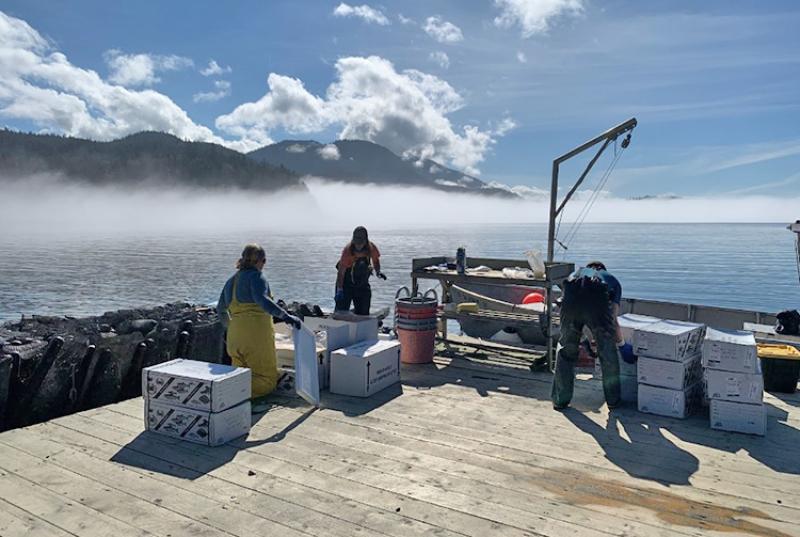NOAA Fisheries meets the needs of our aquaculture stakeholders in Alaska and builds sustainable marine aquaculture. Alaskan aquaculture has room to grow, and efforts are underway to promote and expand this sustainable industry. This report provides a summary of the accomplishments for each of our identified priority areas.
Marine aquaculture — also referred to in Alaska as mariculture —helps support Alaska’s blue economy, contributing to sustainable seafood, and local economies. Seaweed and shellfish aquaculture have been shown to provide ecosystem benefits including creating habitat for fish and invertebrate species. Aquaculture also establishes economic opportunities by creating jobs, supporting eco-tourism, and other pathways.
“A highlight of this year has been the close collaborations with our partners. From the interagency working group’s success on the Permitting Portal to our engagement with Alaska native communities to develop a mobile aquaculture unit, we have listened to the needs of our stakeholders and responded with funding, tools, and expertise,” said Regional Aquaculture Coordinator Alicia Bishop.
NOAA Fisheries supports cutting-edge aquaculture science and research, as well as federal policy-making and regulation. We work closely with partners to improve and expand opportunities to promote sustainable marine production of shellfish and seaweed. Partners include but are not limited to:
- Coastal communities
- State of Alaska
- Aquaculture industry
- Alaska Native governments, communities, and organizations
- Non-governmental organizations such as the Alaska Mariculture Alliance
"Our research priorities and accomplishments over the past year were in direct response to the stated needs of the industry and coastal communities in Alaska to help ensure that the aquaculture industry grows in ecologically and socially sustainable ways," said Aquaculture and Macroalgae Lead Research Biologist Jordan Hollarsmith.
We developed the Joint Aquaculture Action Plan in 2020 to strategically align the work being done by both the regional office and science center, help accomplish the goals of NOAA Fisheries Marine Aquaculture Strategic Plan, and meet industry and management needs identified in the Alaska Mariculture Development Plan.
For Fiscal Year 2022, we identified annual priorities that advanced three of the four strategic goals identified in the NOAA Fisheries Marine Aquaculture Strategic Plan: Goal 1 - Regulatory Efficiency; Goal 2 - Tools for Sustainable Management; and Goal 4 - Informed Public.
Under the strategic goals, the Alaska Aquaculture Program prioritized the following focus areas in fiscal year 2022:
- Improve existing permitting processes for marine aquaculture in state waters
- Employ genetics to protect natural populations
- Advance the understanding of the interactions of aquaculture and the environment
- Improve production efficiency and wellbeing
- Build partnerships to increase outreach and education capacity
Improving Diversity and Inclusion in Aquaculture through Dulse Farming Youth Education
To increase and celebrate diversity across the aquaculture sector, we partnered with members from
the Chilkat Indian Village and Chilkoot Indian Association. We helped develop materials and a curriculum to grow a traditionally important seaweed, Ḵ’aach’, in a K-12 classroom in Klukwan.
Ḵ’aach’, also known as red ribbon algae or dulse, is a traditionally important seaweed species. It has been harvested for millennia by the Tlingit people and other tribes in Southeast Alaska. Tribal members expressed concern that this vibrant red algae may be threatened by climate change, nearshore contamination, and harvesting pressures. In response, we developed a mobile aquaculture unit and curriculum. These were shared with rural and urban classrooms in Alaska aimed to involve students and communities in seaweed education and cultivation.
Alaska Fisheries Science Center Aquaculture Research Strategic Plan
The Alaska Fisheries Science Center released its new strategic research plan for shellfish and seaweed aquaculture in Alaska. This research plan will be used to guide science center aquaculture-related research over the next 5 years. It will provide information for the aquaculture industry, state and federal regulatory agencies, and coastal communities in Alaska. It supports NOAA Fisheries efforts to ensure a sustainable seafood supply and economic opportunities for U.S. citizens.
As Alaska’s nascent marine aquaculture industry continues to grow, NOAA Fisheries Alaska Regional Office and Alaska Fisheries Science Center will play an increasing role in the management, policy, and research that helps build this sustainable food source. Implementing our Aquaculture Action Plan and Aquaculture Research Strategic Plan helps our agency prioritize efforts based on our agency’s strengths and management and industry needs, focusing our efforts to best serve Alaska.





